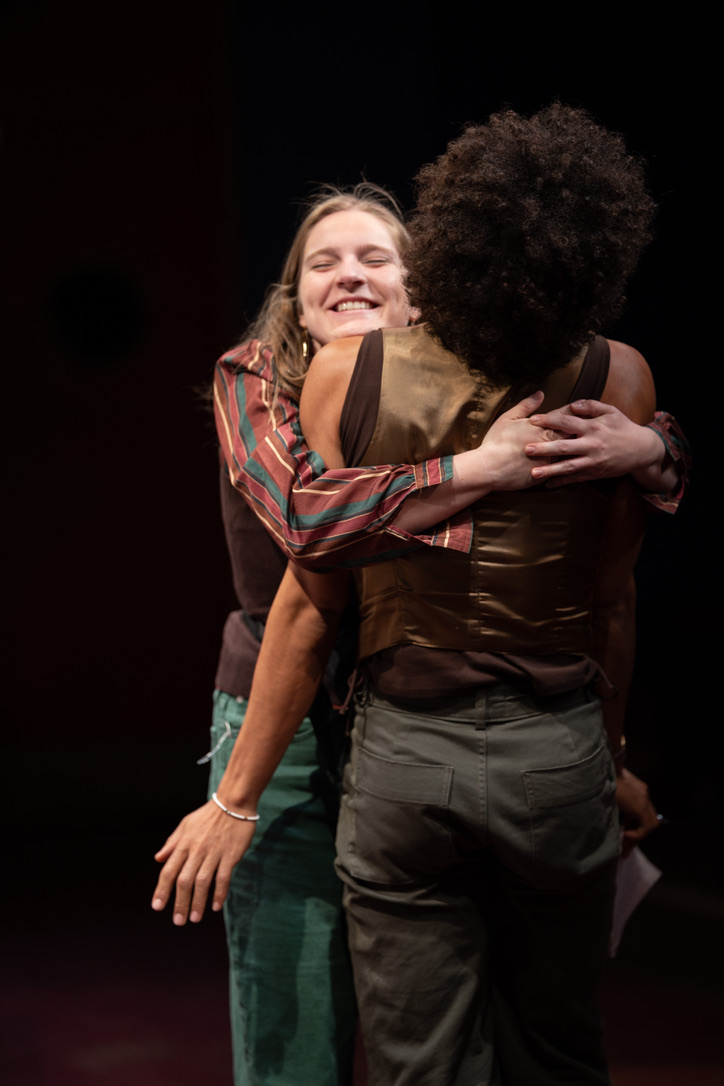A meta comedy about death sounds oxymoronic, but Katie Dragone’s ’22 original play pulls it off in a humorous, touching and slightly cheesy manner.
Theater Lab’s newest production, “LINES,” performed from Thursday to Saturday at Pigott Theater to enthusiastic audiences. Written and directed by Katie Dragone ’22, “LINES” zoomed in on the lives of three sisters and their families grieving over their mother’s prolonged death in a hospital room. Despite the heavy topic, the audience was laughing throughout most of the play due to the constant, surprising breaking of the fourth wall.
The story takes place in an empty hospital bed with two bedside tables facing away from the audience. Against the background noise of a heart rate monitor, characters arrive one at a time to talk to Gladys, the dying mother and grandmother. She is not portrayed by any actor but rather imagined to be there by the audience. Each time a character left the stage, something they brought remained — flowers, pictures or stuffed animals.
The play was thought-provoking and deeply personal to the real playwright and director, Dragone. “The only way I could write the director’s note was by reflecting on my experiences with the creative process and mourning the loss of my own grandmother,” Dragone said in the playbill. The direction of the play parallels her mourning experience. The play gave the audience two stories to watch — one of the grief and humor of family interactions, and another of the grief and humor of writing a play.
After a few morose monologues from the family members, a person in the front row popped up from her seat and paused the show, revealing herself to be the playwright who was unsatisfied with what she had written so far. The playwright, portrayed by Simon Covington ’23, started to lament her own writing, asking if anyone in the audience even liked the play. One audience member near the back of the theater raised her hand.
“I like it,” she said cautiously. When asked her name by the playwright, she said, “I don’t know.” She explained that she didn’t have a name because she was a part of the play and therefore just a figment of the playwright’s own mind.
She was subsequently named “audience member #1” by the playwright, joining her on stage in conversation regarding the purpose of the play. In a particularly memorable line, the playwright asks audience member #1, “Am I a narcissist? Or just an artist?”
The rest of the play unfolded in a similar manner, as the actors were constantly interrupted by the playwright rewriting their scenes. The banter between audience member #1 (Anna Mistele ’23) and the playwright was the most entertaining part of the show, serving to break up the awkward interactions between estranged family members.
The show was an impressive feat of lighting, sound and set design, constantly evolving and changing to accommodate the playwright’s needs. (One of my favorite characters was one who was not even physically present, Ruth the lighting director, who liked to mess with the playwright by not taking her cues.) The actors had keen senses of comedic timing, knowing just when to hold a joke or roll their eyes.
The character of Gerry, one of Gladys’ daughters (Rachelle Weiss ’26), was the most compelling. Her estrangement from the family was apparent in interactions between Gerry and her sisters, Lucy (Sharon Wambu ’24) and Lester (Evelyn Kuo ’23), who resist speaking to her. Her delivery of an emotional speech to Gladys, complete with sincere sorrow and engaging physical acting, won my heart over.
The climax of the show came when the playwright took center stage herself. After dancing around the stage (both literally and metaphorically), she finally stands at the foot of the hospital bed and speaks to Gladys, asking why Gladys couldn’t have more time with her. It became evident that the playwright is related to Gladys herself.
The audience then came to the realization that the play was not just the playwright’s brainchild, but also a mechanism by which she processes her grief. The play ends when she utters, “I wish,” and the rest of the cast joins her on stage for an embrace. It was the most heartfelt moment of the production, as Gladys’ family members and non-family members alike stood together in unity.
Editor’s Note: This article is a review and includes subjective thoughts, opinions and critiques.
